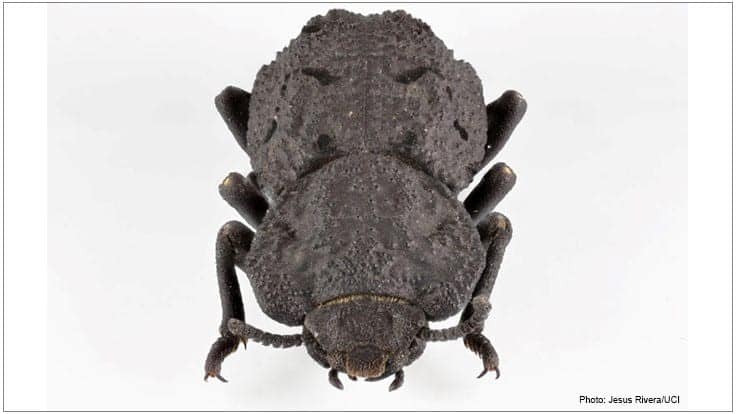
(Photo: Native to desert habitats in Southern California, the diabolical ironclad beetle has an exoskeleton that’s one of the toughest, most crush-resistant structures known to exist in the animal kingdom. UCI researchers led a project to study the components and architectures responsible for making the creature so indestructible. Jesus Rivera / UCI)
IRVINE, Calif. – With one of the more awe-inspiring names in the animal kingdom, the diabolical ironclad beetle is one formidable insect. Birds, lizards and rodents frequently try to make a meal of it but seldom succeed. Run over it with a car, and the critter lives on.
The beetle’s survival depends on two key factors: its ability to convincingly play dead and an exoskeleton that’s one of the toughest, most crush-resistant structures known to exist in the biological world. In a paper published today in Nature, researchers at the University of California, Irvine and other institutions reveal the material components – and their nano- and microscale blueprints – that make the organism so indestructible, while also demonstrating how engineers can benefit from these designs.
“The ironclad is a terrestrial beetle, so it’s not lightweight and fast but built more like a little tank,” said principle investigator and corresponding author David Kisailus, UCI professor of materials science & engineering. “That’s its adaptation: It can’t fly away, so it just stays put and lets its specially designed armor take the abuse until the predator gives up.”
In its desert habitat in the U.S. Southwest, the beetle can be found under rocks and in trees, squeezed between the bark and the trunk – another reason it needs to have a durable exterior.
Lead author Jesus Rivera, a graduate student in Kisailus’ lab during the project who has since earned his Ph.D., first learned of these organisms in 2015 during a visit to the renowned entomology museum at UC Riverside, where he and Kisailus were working at the time. Rivera collected the beetles from sites around the Inland Empire campus and brought them back to Kisailus’ lab to perform compression tests, comparing the results to those of other species native to Southern California. They found that the diabolical ironclad beetle can withstand a force of about 39,000 times its body weight. A 200-pound man would have to endure the crushing weight of 7.8 million pounds to equal this feat.
Learn more about the UC-Irvine’s work with these beetles.
Source: UC-Irvine

